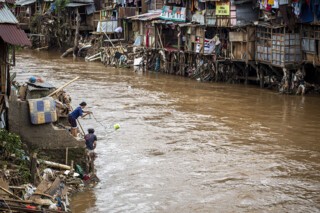‘Not Normal Rain’
Krithika Varagur · In Jakarta
An Indonesian myth has it that Java, now the world’s most populous island, was floating through the ocean until the Hindu god Shiva ordered Brahma and Vishnu to fill it with people. They nailed Java to the tropics using parts of Mount Meru, the sacred mountain of the gods. The fragments became the volcanoes that dot the Indonesian archipelago.
Jakarta, Indonesia’s capital, is on the northwest coast of Java. In 1900 it had about 115,000 residents; in 1970 about 4.5 million; today, there are more than 10 million in the city proper. Its metropolitan area is the largest in Southeast Asia. The floods in Jakarta last week were the heaviest in recorded history and have claimed at least sixty lives. But it’s a difference of scale, not kind. The floods come every year.
Yunarso lives in a small kampung, or informal settlement, in West Jakarta. It was one of the worst-affected areas, with over a metre of floodwater inundating the houses. ‘Did we prepare for this?’ the 36-year-old said. ‘No, nothing. We were celebrating New Year’s Eve until it was late. Then we laid our heads down for a moment and in the morning the water was everywhere.’
‘What can you do? This is Indonesia,’ said his father, Sukarman, the elected head of the neighbourhood. He grew up in Central Java and moved to the city when he was 19. ‘Where I grew up, it flooded the rice fields. Here, it floods our houses. But either way, this is what happens during the season.’ Neither of them has plans to relocate.
As I walked around, three days into the new year, my feet squelching in mud, I saw groups of children with plastic nets, trawling the waterways for catfish. ‘Are those safe to eat?’ I asked Yunarso. ‘Of course,’ he said. ‘They’re like pond fish.’ The water was grey, with black detritus floating on top. Fetid pools of water and mud stretched out in every direction.
Just outside the kampung were rows of mega-mansions, now seemingly with moats. Near one mock Palladian villa, teenage boys admired their catch of the day under a plaster statue of a maenad. But here, too, the acrid smell of garbage and sludge was pervasive. And many of these houses, too, did not escape the floods this year.
An aerial photo went viral on New Year’s Day, showing the Shangri-La Hotel with its manicured grounds and cerulean pool, seemingly untouched – there were even a few swimmers – while the ordinary houses nearby were submerged in brown floodwater.
Many residents of kampungs in north and west Jakarta said no formal relief had reached them. More than 400,000 people have been displaced and there are two more months of heavy rains ahead. The governor of Jakarta, Anies Baswedan, has been criticised for allocating more money to an upcoming Formula E race than to flood mitigation.
The natural disasters ministry has acknowledged that the extreme weather is in part a result of climate change: ‘The rain this time,’ it said, ‘was not normal rain.’ Whether it’s normal or not, Jakarta is especially vulnerable.
The city lies in a large floodplain, downstream of such high-rainfall regions as the Puncak hills, and 40 per cent of the city is technically below sea level. Dams might be helpful: there were eight hundred in the Dutch colonial era, but only about two hundred remain today and 80 per cent of them are useless, according to Jakarta’s Urban Poor Consortium. Most of the swampland underlying the city has been drained in the last half-century because of development. Parts of Jakarta are sinking 25 cm per year, sixty times faster than Venice.
Many have taken the floods as evidence to support Indonesia’s plan to relocate its capital city to Borneo. It makes no sense to live here any more, they say. Perhaps. But not everyone would move, and the relocation would deplete the city’s disaster management resources even further. And what happens when there’s nowhere left to move to? As Jakarta flooded, across the Timor Sea, Australia burned. For how much longer will Melbourne and Sydney be considered among the world’s ‘most liveable’ cities?
For the millions who will stay in Jakarta to see next year’s floods, the Urban Poor Consortium insists that ‘a better city is possible.’ A few years ago, Governor Joko Widodo and his deputy, Basuki ‘Ahok’ Tjahaja Purnama, embarked on an ambitious project to ‘normalise’ the city’s rivers – dredging them, straightening their banks, lining them with walls – which brought relief to the people living beside them for the first time in decades. Ahok, who became acting governor when Widodo became president of Indonesia, suggested that Jakarta could be flood-free by 2022, which sounded crazy, then briefly possible, and now rather hopeless; Ahok lost the 2017 gubernatorial election to Baswedan, went to prison for blasphemy, and has said he is finished with politics. Last June a plan was approved to build a 25-mile sea wall across Jakarta Bay. Construction is supposed to begin in 2023. Meanwhile, the waters continue to rise, Jakarta sinks, and the rain comes down.

Comments